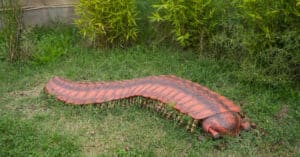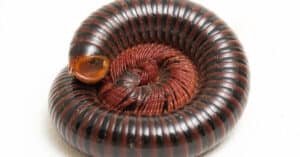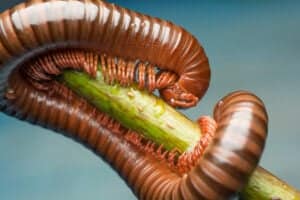Millipedes aren’t exactly one of the most popular animals in the world. When they are thought of, it’s usually in relation to a pest-control problem. There is a dedicated pet community that enjoys taking care of millipedes, and of course, scientists are interested in untangling the web of nearly 80,000 suspected millipede species crawling around today, but by in large, most people don’t know much about or care about millipedes. Let’s try to change that with this examination of the largest millipedes in the world!
Millipedes and centipedes are often grouped together. While they share some general commonalities, millipedes have more legs and are generally herbivorous. Centipedes, however, are usually venomous and can inflict painful bites. Millipedes also have two sets of legs per body segment, while centipedes have one.
The class of Diplopoda, which millipedes fall under, is a large class of arthropods, which means, despite their appearance, millipedes are not insects. Millipedes are generally recognized due to their abundant leg pairs. Most millipedes have more than 20 body segments and are largely herbivorous. Their name is actually misleading; no millipede has 1,000 legs, although the Illacme plenipes in California can have up to 750 legs, officially making it the leggiest animal on earth. Generally, these creatures are quite small, with measurements ranging from millimeters to inches. There are, however, some notable exceptions, and they’ve made our list of the top five largest millipedes in the world.
5. American Giant Millipede (Narceus americanus)
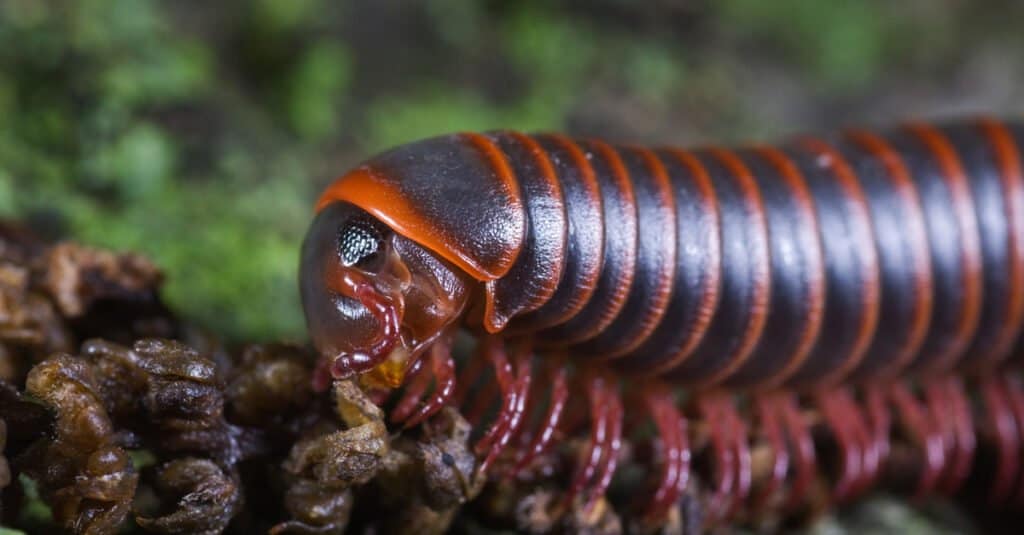
©Gerry Bishop/Shutterstock.com
- Size: Up to 4.02 inches long
- Habitat: Temperate and humid forests along the eastern seaboard of the US (west to Texas)
One of the most commonly sighted millipedes in North America, this herbivorous arthropod moves primarily on the forest floor, under leaf litters, around trees, and in woodpiles. The body of this millipede is largely tubular and appears dark with red or red-orange bands on each segment. The American giant millipede is also sometimes called the iron worm. If picked up, the millipede may secret a liquid deterrent, but it is harmless to humans and will only discolor the skin temporarily.
4. Smokey Oak Millipede (Narceus gordanus)
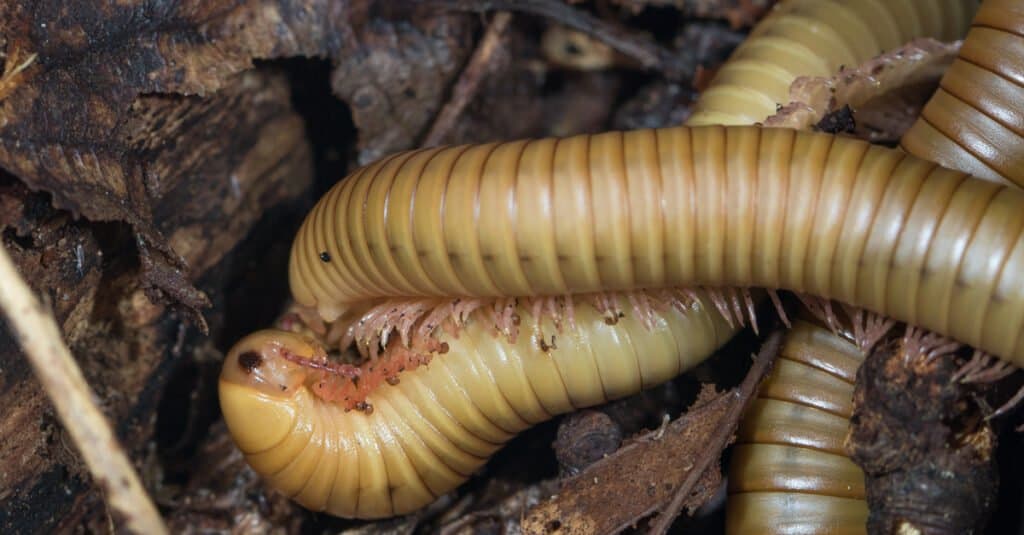
©skippy666/Shutterstock.com
- Size: Up to 4.7 inches long
- Habitat: Florida scrub, South Carolina, and possibly Tennessee
The smokey oak millipede is an American millipede with anywhere from 45-60 body segments. The body color of this millipede is a light greenish tan with a band of darker tan. Compared to other Narceus species, the smokey oak has shorter legs and a deeper groove on its head, where the antennae rest. It is an herbivorous arthropod that enjoys feeding on decomposing wood and leaves.
3. Sonoran Giant Desert Millipede (Orthoporus ornatus)
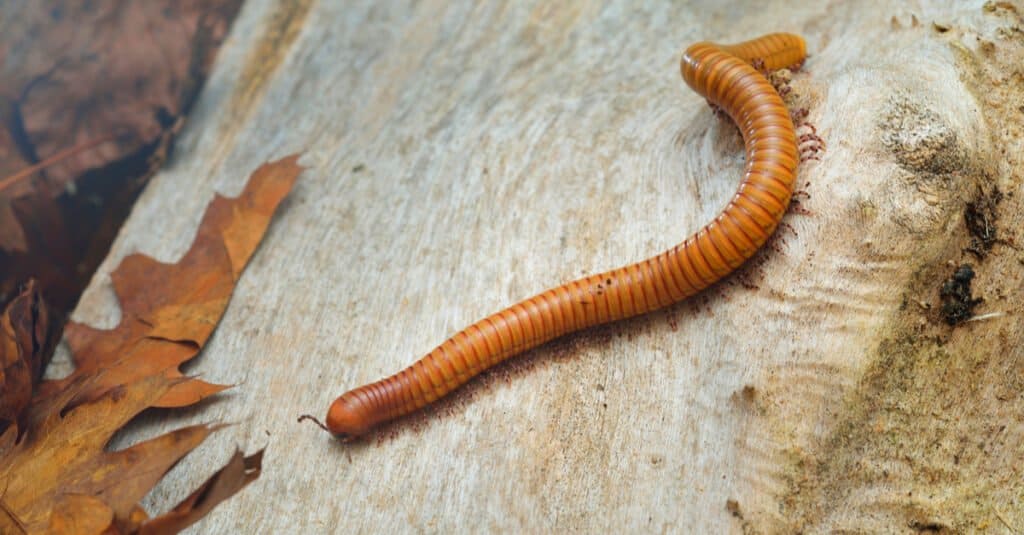
©Alex Stemmers/Shutterstock.com
- Size: Up to ~9 inches long
- Habitat: Desert environments in the southwestern US and northern Mexico
The Sonoran giant desert millipede is a large millipede that has been observed in the US state of Arizona, New Mexico, and Texas, along with the many Mexican states. Like many millipedes, the giant desert millipede has a set of sensory organs found near the head and the base of the antennae called Tomosvary organs. Unlike many millipedes, this variety can live up to 10 years in the wild.
The giant desert millipede is often a brownish hue but can also be yellow. They enjoy staying underground for long periods in the deep, damp soil of their desert habitat. The porous makeup of the soil provides ample places for the millipede to move along with food and shelter from harsh surface elements. Typical of millipedes, the Sonoran giant desert is largely harmless but will curl up into a ball when it feels threatened. In rare cases, the millipede may also release a toxic substance from the sides of its body, which smells bad and is designed to discourage predators from feeding on it. If the toxic substance gets on human hands, it can irritate the skin and eyes.
2. African Giant Chocolate Millipede (Ophistreptus guineensis)

©iztverichka/Shutterstock.com
- Size: Up to 10 inches
- Habitat: Ghana and Nigeria in dry Savannas
This large millipede is originally from Ghana and Nigeria. Due to its ease of handling, it has been a part of the pet trade for a long time. The name comes from the lighter brown coloration, which resembles chocolate. This millipede prefers munching on leaves, bark, soft fruits, and vegetables.
Due to the absolutely enormous variety of millipedes on earth (only 12,000 of a possible 80,000 have been identified), comprehensive information about the giant chocolate millipede is lacking. Most details are found on pet care websites as the chocolate millipede has developed a reputation as an easy millipede to care for.
1. African Giant Millipede
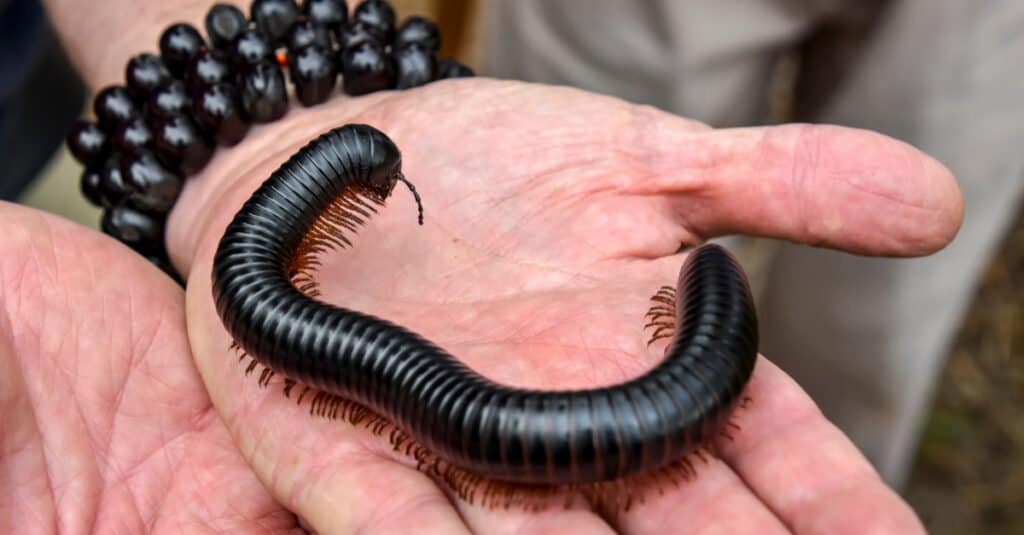
©Wandel Guides/Shutterstock.com
- Size: Up to ~15 inches
- Habitat: Subtropical forests of Africa and parts of Oman
The African giant black millipede is the largest living millipede in the world, capable of growing over a foot long! Like many millipedes, it is generally harmless, living its life on the forest floor and munching on organic matter. The giant black millipede is mostly found in lowland parts of East Africa, although it is also native to the Dhofar region of Oman.
The African giant millipede also has a symbiotic relationship with mites. The mites, which are tiny arachnids, crawl around on the exoskeleton of the millipede and help clean it. The millipede gets a clean exoskeleton, and the mites get food and protection from the millipede. While the relationship is beneficial to both parties, the mites have been known to cause agricultural damage, so the US and Canada have banned the entry of the millipede into their territories.
The Largest Extinct Millipede Species

The largest millipede to ever roam the Earth was Arthropleaura
©FABRIZIO CONTE/Shutterstock.com
While the African giant millipede is the largest living millipede today, it wasn’t always so. To find the biggest millipede of all time, we need to travel back to the Carboniferous period (358.9-298.9 million years ago). Before dinosaurs walked the earth, the genus Arthropleura contained the largest millipedes of all time. From fossil analysis, scientists have concluded that species of Arthropleura may have grown as long as 8 feet! While they were most likely still herbivorous, seeing an 8-foot millipede in the wild would likely be heart-attack-inducing and makes the African Giant seem tiny by comparison.
The photo featured at the top of this post is © Piyapong pc/Shutterstock.com
Thank you for reading! Have some feedback for us? Contact the AZ Animals editorial team.



